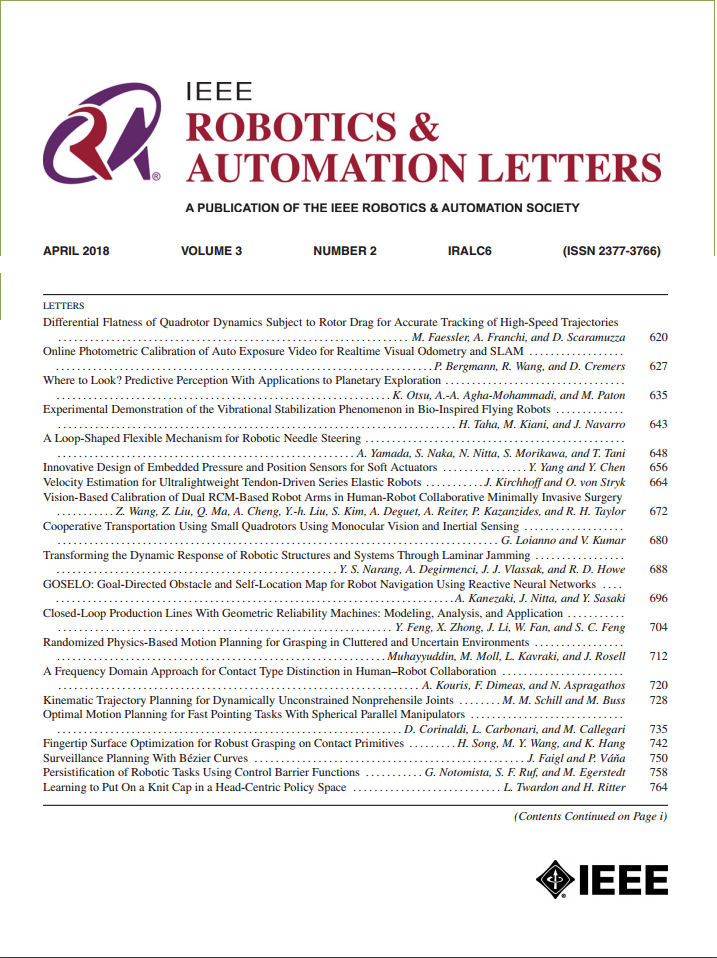ShapeICP:基于深度的迭代分类级对象姿态和形状估计
IF 5.3
2区 计算机科学
Q2 ROBOTICS
引用次数: 0
摘要
基于单一深度图像的类别级物体姿态和形状估计由于其在机器人操作等任务中的潜在效用而引起了研究的关注。这项任务特别具有挑战性,因为三个未知数,物体姿态,物体形状和模型到测量的对应关系,是复合在一起的,但只提供了一个深度测量的单一视图。大多数先前的工作严重依赖于数据驱动的方法来获得至少一个未知数的解决方案,通常是两个,如果不仔细设计和训练,可能会导致泛化失败。先前工作中使用的形状表示也主要集中在点云和符号距离场(sdf)上。与之前的工作形成鲜明对比的是,我们使用迭代估计方法来解决问题,该方法不需要从姿态注释数据中学习。此外,我们构建并采用了一种新的基于网格的对象活动形状模型(ASM),与常用的基于点的对象活动形状模型相比,该模型还保持了顶点的连通性。我们的算法ShapeICP是基于迭代最近点(ICP)算法,但为类别级姿态和形状估计任务配备了额外的特征。虽然没有使用姿势注释数据,但ShapeICP超越了许多依赖姿势数据进行训练的数据驱动方法,为研究人员开辟了一个新的解决方案空间。本文章由计算机程序翻译,如有差异,请以英文原文为准。
ShapeICP: Iterative Category-Level Object Pose and Shape Estimation From Depth
Category-level object pose and shape estimation from a single depth image has recently drawn research attention due to its potential utility for tasks such as robotics manipulation. The task is particularly challenging because the three unknowns, object pose, object shape, and model-to-measurement correspondences, are compounded together, but only a single view of depth measurements is provided. Most of the prior work heavily relies on data-driven approaches to obtain solutions to at least one of the unknowns, and typically two, risking generalization failures if not designed and trained carefully. The shape representations used in the prior work also mainly focus on point clouds and signed distance fields (SDFs). In stark contrast to the prior work, we approach the problem using an iterative estimation method that does not require learning from pose-annotated data. Moreover, we construct and adopt a novel mesh-based object active shape model (ASM), which additionally maintains vertex connectivity compared to the commonly used point-based object ASM. Our algorithm, ShapeICP, is based on the iterative closest point (ICP) algorithm but is equipped with additional features for the category-level pose and shape estimation task. Although not using pose-annotated data, ShapeICP surpasses many data-driven approaches that rely on pose data for training, opening up a new solution space for researchers to consider.
求助全文
通过发布文献求助,成功后即可免费获取论文全文。
去求助
来源期刊

IEEE Robotics and Automation Letters
Computer Science-Computer Science Applications
CiteScore
9.60
自引率
15.40%
发文量
1428
期刊介绍:
The scope of this journal is to publish peer-reviewed articles that provide a timely and concise account of innovative research ideas and application results, reporting significant theoretical findings and application case studies in areas of robotics and automation.
 求助内容:
求助内容: 应助结果提醒方式:
应助结果提醒方式:


